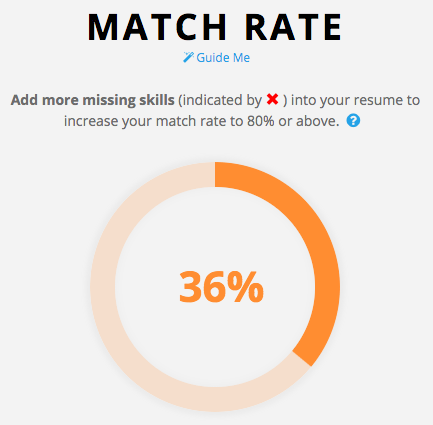Step 1: Are you applying for the right role?
Are your job applications going into an online black hole, never to be seen again?
If so, you may be applying for the wrong role.
Specifically, you may not seem like a credible candidate to the recruiter, which is why you’re never hearing back.
The easiest way to find out is to run your resume through Jobscan. If your match rate with your desired job’s keywords is low, ask yourself “Do I already have these skills?”
If so, just make sure to include them using the technique described below.
If not, consider applying for another role that’s a better fit for your existing skills.
Step 2: Do you have the right keywords on your resume?
If you have the actual skills needed for the job but not the right keywords according to Jobscan, it’s most likely that your resume is getting blocked by the Applicant Tracking System (ATS).
Since this system screens resumes for the keywords in the job description, it’s essential that you include them. Just don’t get hung up on the language.
As you’ll see in the Recommended Keywords for each role, tech job descriptions tend to use lots of lingo (e.g., “set OKRs” = "establish goals”). But chances are that you’ve actually got the underlying experience, so be sure to take credit for it!
In a sea of thousands of boring resumes, make sure that yours stands out!
Step 3: Is Your Resume Impressive Enough?
If your resume has the right keywords, chances are that the ATS is passing it on to an actual human recruiter.
But even a human recruiter’s attention is limited to 5-10 seconds per resume since they’re often juggling 10+ open jobs with 1,000+ applicants each!
So your resume needs to instantly scream: “I’m awesome.”
And the easiest way to do that when the recruiter is going 100 miles an hour is to include visual signals of quality:
Impressive brands: “Partnered with Google to overhaul my school’s IT system”
Big numbers: “Saved my company more than $50,000 by renegotiating our equipment contract”
Accolades: “Selected to serve on our employee board of advisors by the CEO”
Step 4: Are you falling into classic job search traps?
Even with a great resume, you can still get rejected if you fall into these typical traps:
You’re only applying to the most famous companies
With a .2% acceptance rate (vs. 1% on average), only applying to companies like Google is a recipe for never getting an interview; try applying to a broader set of companies to accelerate your progress
You’re not submitting a cover letter
While many recruiters don’t read cover letters, the recruiters who do care deeply about them; use my cover letter template to produce a personalized, powerful letter in just 10 minutes
You’re applying too late
Just like no one still craves turkey a week after Thanksgiving, no recruiter wants to see more applications a week after getting 1,000+ resumes; so set-up daily job alerts and then apply in the first 96 hours to 8X your chances
Jobvite data shows referred candidates are 10X more likely to get hired than those who just apply online
Step 5: Did You Get a Referral?
By far, the single biggest predictor of whether you’ll get an interview is whether you got a referral.
That’s because having someone on the inside advocate for you transforms you from an outsider (i.e., easy to reject) into a member of the tribe (i.e., friends don’t reject friends!).
And the stats don’t lie - you’re 10X more likely to succeed with a referral than just applying online.
So learn how to get a referral, even if you don’t know anyone inside your desired company!
Step 6: Did You reach out to the hiring manager?
Lots of candidates reach out to recruiters. After all, aren’t they the person who controls your career fate?
Nope.
While it’s true that recruiters can be the gatekeepers to an interview, they’re also typically juggling 10+ jobs at any time.
Which means that they don’t really care about finding the perfect candidate for any given role. And so they’re unlikely to invest time in getting to know all of the thousands of candidates applying for all their openings.
Whereas the hiring manager (i.e., your future boss) is often only hiring for one role. And so she cares a lot about finding the exact right candidate - especially because she’ll still be stuck with you long after the recruiter has moved on!
Which is why reaching out to her is way more important than contacting the recruiter. And here’s exactly how to find hiring managers looking for great talent right now!
Yesware data reveals that many recipients won’t respond until after you’ve followed-up with them.
Step 7: Did You follow-up?
So you reached out to the hiring manager. And to get referrals. But did you follow-up?
If not, you’re leaving money on the table.
That’s because many people don’t respond to the first email they receive - but WILL respond to subsequent messages.
Whether that’s due to missing your first message, being impressed with your persistence, or just plain guilt, follow-ups flat out work.
So be sure to grab Boomerang and set follow-ups for all your emails. And never let a golden opportunity slip through the cracks again!
Bonus step: Take the Course
If you want to really maximize your chances of getting interviews, check out my online course.
It’s got a step-by-step process to boost your odds at each step of the application process (including an optional resume review):
Leverage my personal resume template that’s earned offers from Google and Amazon to Udacity and 23andMe
Optimize your LinkedIn profile so you start getting interview requests straight from recruiters
Connect directly with insiders at any company in the world - from recruiters all the way to your future boss
“My completion percentage of Jeremy’s course had an almost direct correlation with me getting a job.”

















